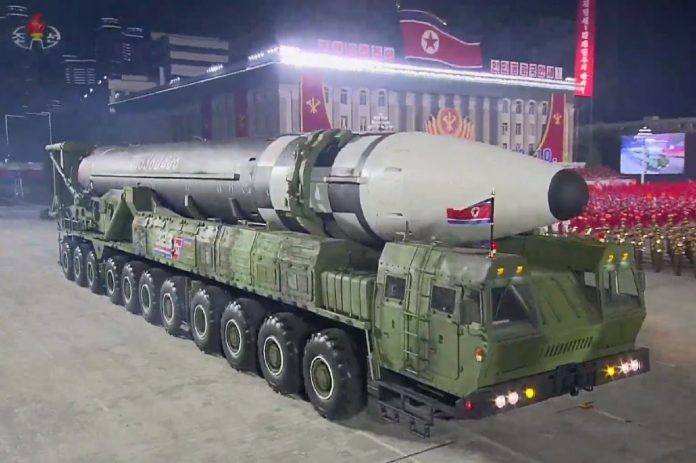At the 75th anniversary of North Korea’s ruling Workers’ Party celebrations that were held on Oct. 10, one fact was made clear by the pageantry of the military arsenal that the ‘price tag’ for North Korea to relinquish its nuclear arsenal had just escalated. To assume that what Kim Jong-un was hoping to achieve from the presentation of North Korea’s military might was only to show off how far the country has come in its development of nuclear arsenals is to ignore that the parade was also meant as a clear message to the United States. Even though several denuclearization talks were held between Kim Jong-un and the United States President, the talks failed to deter North Korea’s nuclear arsenal. In contrast, the denuclearization talks managed to buy time for Pyongyang to garner the material it needed to build what is now being considered one of the largest mobile Intercontinental Ballistic Missile (ICBM) after its predecessor the Hwasong-15. Countries with ICBMs generally seek to make their road-mobile ICBMs smaller so they can be more mobile and concealable. The additional ICBM, presumably a Hwasong-16 has managed to secure Kim Jong-un a ‘strategic bargaining position of power’ entering any talks on denuclearization that Pyongyang has always wanted.
It has always been clear that Pyongyang was willing to use all kinds of tactics to make sure that negotiations on denuclearization would bear close to no results particularly when it comes to relinquishing the nuclear program. While the topic of North Korea’s fascination has been overly researched, there has been a consistent underlying tone that the ‘Hermit Kingdom’ would not easily let go of a nuclear program that it believes to be strategically serving both on the negotiating table with the U.S. and domestically as a tool for the survival of the Kim family’s hold on power. The view in Washington and Seoul is that Kim remains unlikely to give up his nuclear arsenal, said Wi Sung-lac, a former nuclear envoy for South Korea. The conundrum that is presented by such recognition by both the U.S. and South Korea is how to deal with a rogue nuclear state that is showing no signs of either wanting to stop or relinquish its nuclear material. Furthermore, the question arises of whether it is time that the global nuclear nonproliferation regime and its proponents figure out whether it is more important to ban North Korea’s nuclear armament buildup or to control the progression of its nuclear capability as was the case with the Iran nuclear program.
A senior U.S. administration official called the display of the ICBM “disappointing” and called on the government to negotiate to achieve complete denuclearization. As it stands the prospects of a nuclear deal that involves the complete irreversible and dismantlement of North Korea’s nuclear program appear slim, but verifiable verification protocols could still be a possibility in a deal that attempts to curb the expansion of the nuclear capability. The architects of the complete, verifiable, irreversible, and dismantlement (CVID) of North Korea’s nuclear program should not lose hope but shift focus into creating a ‘verifiable and verification’ path that acknowledges North Korea’s nuclear capability but still work toward curbing further development of that capability. Kim Jong-un has already sealed his negotiating position for potential denuclearization talks by presenting the current ICBM and it is now up to Washington and Seoul how they one up Pyongyang. However, it remains unproven whether the new ICBM is ready for testing, let alone a strike.
One could argue that the presumed Hwasong-16, is generally a boost when it comes to optics of North Korea’s weaponry. 38 North a North Korea-focused website, points out how the ICBM is a classically Khrushchevian statement of North Korea’s technical prowess, the robustness of its ability to threaten the U.S., and the permanence of its nuclear weapons status. This proves that North Korea continues to be strategic and methodical in its use of tactics that bring attention to the development of the nuclear program. While some rogue nuclear states have chosen to be covert in their enrichment of nuclear capability, North Korea is bringing its nuclear capability to the forefront of the discussion with pomp and pageantry to set its position and the narrative of nuclear talks with Washington and Seoul. The technical prowess of the upgrades to soldiers’ infantry gear, a next-generation submarine-launched ballistic missile (SLBM), and the new ICBM also brings awareness to how North Korea has been able to upgrade the weaponry to such a standard amidst U.S. economic sanctions that have been meant to cripple North Korea’s nuclear program.
Policymakers and academics have continued to express concern that North Korea would export nuclear material or components, but the focus should also shift to the countries that might be covertly funding North Korea’s nuclear program. Targeted economic sanctions that have been directed toward North Korea to curtail its nuclear ambitions have so far not affected the nuclear program in the desired manner but have had an adverse reaction. It would be fair to assume that Pyongyang has found illicit means to fund the development of the military artillery that was on full display at the parade on Oct. 10, particularly the new ICBM estimated in principle, to deliver 2,000-3,500 kg of payload to any point in the continental United States — much greater than the Hwasong-15’s assessed 1,000 kg payload capability to the same range. Based on the data on North Korea’s economy and how the economic sanctions have been strategically put, it can be argued that the international community has failed to follow through on its use of economic statecraft to make sure that North Korea stops finding means to continue with illicit activities geared to nourish and sustain the clandestine nuclear armament program. It is time for the United States and its allies to stop relying on verbal statements from Pyongyang guaranteeing compliance because if there is one certain thing – it is that North Korea will subvert compliance and systematically break the rules.
Winston Churchill once advised states to investigate history because of its abundance of secrets of statecraft. This notion is relevant for the U.S. and the international community in the strategies and tactics they could apply in future negotiations with North Korea on the nuclear program. One repetitive fact about the ‘hermit kingdom’ is that they have been consistent in how to act in denuclearization talks from the Agreed Framework, The Six-Party Talks, and the bilateral talks with Trump from 2017. Therefore, instead of setting up a negotiation campaign that headlines ‘complete disarmament or nothing’ would result in acquiring the same results whereby Pyongyang stalls the negotiations, applies ‘exit and entry brinkmanship tactics’ and other various time delay tactics that would eventually cripple the denuclearization talks without a concrete enforceable agreement. One can recommend the importance of less ambitious but realistic goals that have a possibility of attaining success for instance protocols that limit the continued production of the nuclear arsenal. The Iran nuclear deal could be a model that could be used as a peaceful alternative to curbing nuclear proliferation in DPRK. All facts considered, the success of a denuclearization deal relies on enforceability and how the parties will rigorously move to disrupt, counter and contain any sign of disobedience from a regime that has become synonymous with defying international norms and standards of behavior to acquire weapons of mass destruction (WMD).
The views and opinions expressed in this article are those of the author.

Ian Fleming has an M.A. & B. A. in International Politics by the University of South Africa. He has been published in Asian Journal of Peace. His areas of research include nuclear diplomacy, cybersecurity, and foreign policy. He is currently serving as the Editor in Chief for IAPSS journal ADV and is the Chairperson of the IAPSS SRC on Conflict Security & Crime. Furthermore, he is a member of the Comprehensive Nuclear Test Ban Treaty Organization Youth Group. In addition, he is a board member of the British American Security Information Council’s Emerging Voices Network.


